Abstract
The state of emergency caused by the covid-19 pandemic has shown that teaching at this time is not easy. Teachers have to make more use of distance education and students have to adapt to that. Classic face-to-face study is not possible but asymmetric communication between the teacher and his students may be replaced by greater student independence and greater student effort. Within the subject theory of probability and statistics, a questionnaire was created to find how students manage distance education. It has been found out that they use the prepared tutorial videos and online assignments (in WeBWork platform) the most. They expressed that distance education prepared by the teacher can replace face-to-face study, but this form of learning is much more demanding and therefore they prefer classic face-to-face study.
1. Introduction
The covid-19 pandemic hit the whole world. All schools were closed in the Czech Republic on 11th March 2020. The teaching had to continue. Distance education had to be used and it consisted of providing material for study, using the system for submitting the assigned tasks, filming tutorial videos and sometimes organizing video conferences.
Teachers in primary schools, secondary schools and universities had to react without delay [1,2,3,4,5,6,7,8,9,10,11,12]. All teachers had to switch over to distance education and it was quite challenging, especially for primary school teachers. They had no experience with this form of teaching until then, and they had to adapt to it. Some secondary school teachers had used online learning and assessment systems before and therefore they were not so surprised. Nevertheless, they had to adjust distance education to the circumstances. It was necessary to master the control of various systems for sharing materials, submitting tasks and organizing video conferences. University teachers, on the other hand, use material-sharing and assignment systems more often [13,14]. However, they also had to adapt to the new conditions by holding video lectures for more effective teaching.
This article discusses teaching of the subject theory of probability and statistics during the covid-19 state of emergency using the WeBWork assessment system and other materials for distance learning at University of Pardubice (Czech Republic).
2. Course Theory of Probability and Statistics
The main goal of the subject theory of probability and statistics is to familiarize students with the basic ideas of the theory of probability, necessary for explication of statistical methods and to present fundamental statistical methods used for data processing in technical and economical practice. The syllabus includes:
- (1)
- Combinatorics.
- (2)
- Random event and his probability.
- (3)
- Conditional probability, independence of events.
- (4)
- Random variable.
- (5)
- Characteristics of the random variable.
- (6)
- Some important theoretical probability distributions.
- (7)
- Limits theorems.
- (8)
- Population and random sample, methods of descriptive statistics.
- (9)
- Estimation theory.
- (10)
- Testing hypotheses.
- (11)
- Nonparametric methods.
- (12)
- Linear regression.
- (13)
- Correlation.
In addition to working on tasks in labs (seminars), students have to pass easy online assignments in combinatorics in the WeBWork platform at the beginning of the semester. Gradually (in parts), students also submit a seminar paper, where they process data using statistical software (MS Excel, StatSoft STATISTICA). If students fulfill all the obligations during the semester, they can take the exam.
The first three weeks the subject was taught standardly face-to-face. In this paper, the term face-to-face study refers to the classic full-time study associated with attending university lectures and labs (seminars) by students. After the coronavirus emergency, face-to-face study was replaced by distance learning with the aid of the WeBWork platform, tutorial videos, and online materials. Students’ obligation to work on tasks in labs (seminars) had replaced tasks in the WeBWork platform.
WeBWorK
WeBWorK is an open-source online homework system for math and science courses. In our case, the course for the subject theory of probability and statistics contained step-by-step tasks for individual thematic areas, but also links to tutorials and other online materials (Figure 1). The use of online assessment systems such as WeBWork is discussed in articles [15,16,17].
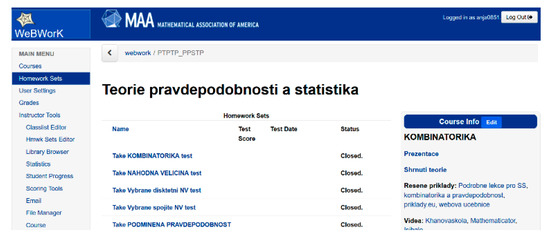
Figure 1.
Course in WeBWork.
As stated by the Mathematical Association of America (MAA) in [18], WeBWorK comes with a National Problem Library (NPL) of over 20,000 homework problems. Problems in the NPL target most lower division undergraduate math courses and some advanced courses. Supported courses include college algebra, discrete mathematics, probability and statistics, single and multivariable calculus, differential equations, linear algebra and complex analysis. WeBWorK is used successfully at over 700 colleges and universities, from large research institutions to small teaching colleges. WeBWorK has been developed and maintained by mathematicians since 1994, always with the goal of providing the mathematical community with the most robust, flexible, and mathematically capable online homework system possible. WeBWorK is open-source and freely available.
3. Teaching Theory of Probability and Statistics during Covid-19 State of Emergency
As already mentioned, the system WeBWork was chosen as the main tool for teaching the subject theory of probability and statistics during the covid-19 state of emergency.
However, other study resources could also have been used by students, such as:
- (1)
- recommended textbooks;
- (2)
- tutorial videos;
- (3)
- other materials provided by the teacher (presentations, solved examples, worksheets);
- (4)
- materials or suggestions from classmates;
- (5)
- other materials available (not provided by teachers or classmates).
3.1. Methodology
The aim of the research was to find out what specific resources of education the students used for learning the subject theory of probability and statistics during the state of emergency, and what sources helped them the most during this time. The students were also asked to evaluate what extent distance education successfully replaced the classic face-to-face study of this course. This item was evaluated by students using the Likert-type scale, one to five stars. One star meant the distance education did not successfully replace face-to-face study at all, and five stars meant it replaced it completely successfully. The comparison between the distance learning and classic face-to-face study was also made to see which form of study is more time-consuming. Students were also able to choose which type of teaching suited them better: the distance study, face-to-face study or if both were the same for them. The frequency of the use of the above-mentioned study resources was also rated by students on a scale: never, sometimes, often and very often. The range of one to five stars was used in a similar way for them to evaluate the usefulness of study materials. One star meant the least useful and five stars meant the most useful. Students were given the opportunity to write comments on questions or suggestions for improvement. They also could choose if they wanted to fill in the questionnaire anonymously or use their names for possible discussion.
The research was conducted using an online questionnaire created via Google service. At the beginning of the questionnaire, students were instructed: all questions, except for the first one, are related specifically to the course of Theory of Probability and Statistics. You can choose multiple answers to the first question.
The questionnaire questions were as follows:
- 1.
- What resources did you use during the state of emergency? (If you have used other materials, please see the section “Other”.)
- (1)
- recommended textbook
- (2)
- tutorial videos
- (3)
- online assignments (e.g., WeBWork)
- (4)
- other materials provided by the teacher (e.g., on STAG)
- (5)
- materials or suggestions from classmates
- (6)
- other materials available on the Internet (not provided by teachers or classmates)
- (7)
- Other: …………………………………….
- 2.
- Which study source helped you the MOST in studying the subject Theory of Probability and Statistics during the state of emergency?
- (1)
- recommended textbook
- (2)
- tutorial videos
- (3)
- online assignments on WeBWork
- (4)
- other materials provided by the teacher (presentations, solved examples, worksheets)
- (5)
- materials or suggestions from classmates
- (6)
- other materials available on the Internet (not provided by teachers or classmates)
- (7)
- Other: …………………………………….
- 3.
- Evaluate to what extent, in your opinion, did the distance teaching successfully replace the classic face-to-face study of Theory of Probability and Statistics? (* means “it did not”, ***** means “it completely did”):
- 4.
- In terms of time required, compare the classic (face-to-face) study and distance study of the Theory of Probability and Statistics.
- (1)
- face-to-face study is more time-consuming
- (2)
- distance study is more time-consuming
- (3)
- it is the same
- 5.
- What type of learning do you prefer?
- (1)
- face-to-face study
- (2)
- distance study
- (3)
- it is the same
- 6.
- How often did you use the following study resources when studying and preparing for the exam in the subject Theory of Probability and Statistics?
never sometimes often very often Recommended textbook Tutorial videos Online assignments on WeBWork Other materials provided by the teacher Materials or suggestions from classmates Other materials available on the Internet Other - 7.
- Evaluate the following study activities according to their usefulness (* means the least useful, ***** means the most useful).
* ** *** **** ***** Studying of recommended textbook Watching videos Working on online tasks (WeBWork) Working on seminar paper Studying of other materials provided by the teacher
Space for comments on questions or suggestions for improvement:
3.2. Results
Out of 58 students registered for the course, 41 students have completed the questionnaire so far.
The first question about study resources during the state of emergency was the only one where students could choose more than one answer. It showed that tutorial videos and online tasks were the resources most often used by students, followed by other materials provided by the teacher. Recommended textbooks and other materials available on the internet were ticked by about half of the students. You can see detailed results in Figure 2.
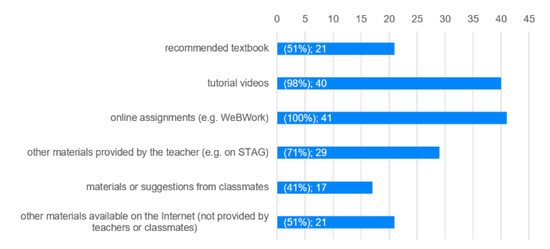
Figure 2.
The frequencies of response to the question: what resources did you use during the state of emergency? (multiple answers possible).
Students (who took advantage of the section “Other”) also wrote that they used:
- -
- Youtube.com & matematika.cz + other resources according to the situation for successful completion of tasks
- -
- Google
- -
- Notebook from last year
- -
- Notes from last year, the book Basics of Statistics by Neubauer, Sedlačík and Kříž (recommended textbook-author’s note)
Answers to the second question regarding the most helpful resources when studying the subject theory of probability and statistics during the state of emergency were similar to the previous answers. The most helpful study resources were tutorial videos and online assignments in WebWork, with 45%. See Figure 3.
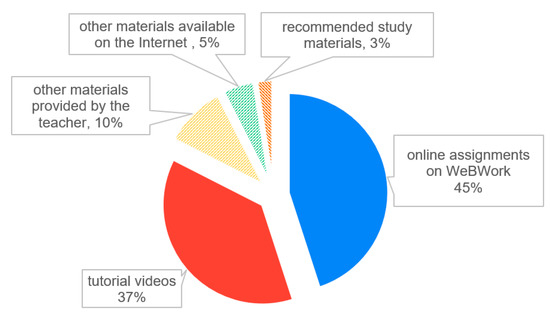
Figure 3.
The frequencies of response to the question: which study source helped you the MOST…?
It is clear from the results that it is appropriate to use these two forms of distance learning and combine them. One student chose the option “Other” where he wrote a combination: Webwork, tutorial videos, and presentations.
The third question dealt with how successfully the classic face-to-face study of theory of probability and statistics was replaced by the distance learning. One star meant it did not replace successfully, and five stars meant it completely successfully replaced the classic learning. As you can see in Figure 4a, four out of five stars on the scale was their most often used rating. The graph shows a clear “skewness” towards successful replacement of the classic face-to-face study. The average is 3.4 stars (see Figure 4b).

Figure 4.
(a) The frequencies of response to the question: evaluate to what extent did the distance learning successfully replace the classic face-to-face study …? (b) Average rating in the number of stars by students.
The next question compared what is more time-consuming, classic learning or distance education. It was question number four, 59% of students answered that distance education was more time-consuming. The results indicating that the study was the same or that the face-to face (respectively full-time as named in the figure) study was more time-consuming were similar, with 22% and 19%. See Figure 5.
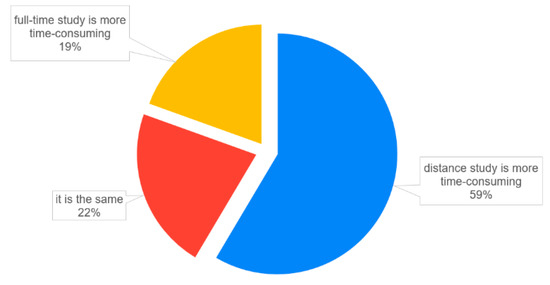
Figure 5.
The frequencies of response to the question: in terms of time required, compare the classic full-time (face-to-face) study and distance study of the Theory of Probability and Statistics.
The results of the fifth question correspond to the previous one. The question was what type of learning the students prefer? The results indicate that 70% of them preferred classic face-to-face (full-time) study, 20% of them preferred distance learning and 10% of them considered both the same. It is clear from these results that classic face-to-face (full-time) study is better for students. See Figure 6.

Figure 6.
The frequencies of response to the question: what type of learning do you prefer?
Question number six dealt with the use of particular study resources. A four-point scale was used: never, sometimes, often, and very often.
It is clear from the graph (Figure 7) that online assignments in WeBWork were used most often (followed by tutorial videos). The results indicate that 31 respondents of the total of 41 respondents reported that they used WeBWork very often. Tutorial videos were used very often by 21 respondents. Teacher provided materials or recommended textbooks or materials available on the internet were used only sometimes and other materials were almost not used at all. See Figure 7.
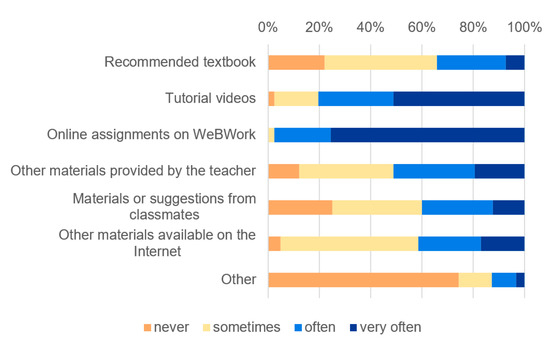
Figure 7.
The frequencies of response to the question: how often did you use the following study resources when studying and preparing for the exam in the subject Theory of Probability and Statistics?
Question number seven evaluated usefulness of various study activities. A five-star scale was used for rating. One star meant the least useful and five stars meant the most useful.
Studying recommended textbooks was often rated in the middle value of usefulness. Watching tutorial videos was often evaluated as the most useful, working on online assignments (WeBWork) was evaluated as the most useful even more often, and elaboration of seminar papers and study from other materials provided by the teacher was evaluated as useful (3 or more stars). See Figure 8.
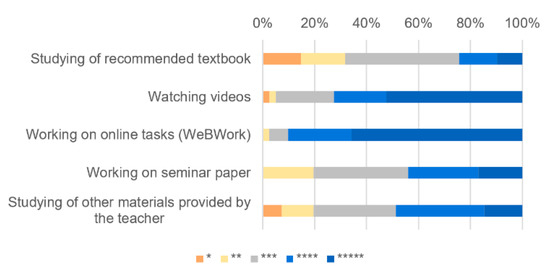
Figure 8.
The frequencies of response to the question: evaluate the following study activities according to their usefulness (* means the least useful, ***** means the most useful).
In the last question, a space was given to write comments on the questions or suggestions for improvement. Students praised the existence of more ways of presenting the content of the subject, they appreciated working on seminar papers, online consultations with the teacher, assignments in WebWork system and the overall preparation made by the teacher. They would advise to keep online tasks in WeBWork, even during classic face-to-face teaching.
4. Conclusions
Teaching during a state of emergency is not easy. Teachers, as well as students, had to use available distance education systems and had to manage all distance learning and teaching. In our study, students evaluated the replacement of classic face-to-face study with distance learning rather successfully (the mode in student evaluation was four out of five stars). Thus, we believe that if different online tools (WeBWork, tutorial videos) and their combination are used, there can be a sufficient replacement. It also turned out that students evaluate these online tools much better than classical textbook (as shown in questions 6 and 7). On the other hand, students claimed that distance form of education is more time demanding, and they generally prefer face-to-face study.
The benefit of this work is the focus on an unfamiliar emergency situation from the perspective of students rather than pure monitoring of their performance results. The limit of this work is that 41 students can be considered as a small number of respondents. Even though 70% of the students attending the course completed the questionnaire, the research can be extended to other courses and generally among more respondents from university students. In spite of the fact that research is not extensive, it responds to the current situation similarly as previous studies mentioned in the introduction. We believe that the conclusion of this paper can help lecturers when considering adding online tools (such as WeBWork) into teaching mathematics and providing distance learning (not only during the state of pandemic emergency).
Author Contributions
Conceptualization, A.J.B. and R.N.; methodology, A.J.B. and R.N.; software, A.J.B.; validation, A.J.B.; formal analysis, A.J.B. and R.N.; investigation, A.JB.; resources, R.N.; data curation, A.J.B.; writing—original draft preparation, A.J.B. and R.N.; writing—review and editing, A.J.B.; visualization, A.J.B.; project administration, A.J.B. and R.N.; funding acquisition, A.J.B. All authors have read and agreed to the published version of the manuscript.
Funding
This research was funded by the Project: DEVELOPMENT OF QUALITY IN EDUCATION, EVALUATION AND STRATEGIC LEADERSHIP AT THE UNIVERSITY OF PARDUBICE, reg. no. CZ.02.2.69/0.0/0.0/16_015/0002320.
Acknowledgments
The online course in WeBWork and other materials mentioned in this paper were created within the Project Development of Quality in Education, Evaluation and Strategic Leadership at the University of Pardubice under the European Union (OP Research, Development and Education) and the Ministry of Education, Youth and Sports of the Czech Republic. The authors also wish to thank the Faculty of Transport Engineering at the University of Pardubice.
Conflicts of Interest
The authors declare no conflict of interest.
References
- Schneider, S.L.; Council, M.L. Distance learning in the era of COVID-19. Arch. Dermatol. Res. 2020, 1–2. [Google Scholar] [CrossRef] [PubMed]
- Daniel, S.J. Education and the COVID-19 pandemic. Prospects 2020, 1–6. [Google Scholar] [CrossRef] [PubMed]
- Dorn, E.; Bryan, H.; Jimmy, S.; Ellen, V. COVID-19 and Student Learning in the United States: The Hurt Could Last a Lifetime; McKinsey & Company: New York, NY, USA, 2020. [Google Scholar]
- Basilaia, G.; Kvavadze, D. Transition to online education in schools during a SARS-CoV-2 coronavirus (COVID-19) pandemic in Georgia. Pedagog. Res. 2020, 5, em0060. [Google Scholar] [CrossRef]
- Melnick, H.; Darling-Hammond, L.; Leung, M.; Yun, C.; Schachner, A.; Plasencia, S.; Ondrasek, N. Reopening Schools in the Context of COVID-19: Health and Safety Guidelines from Other Countries; Learning Policy Institute: Palo Alto, CA, USA, 2020. [Google Scholar]
- Pragholapati, A. COVID-19 Impact on students. OSF 2020. [Google Scholar] [CrossRef]
- Alawamleh, M. COVID-19 and higher education economics. J. Econ. Econ. Educ. Res. 2020, 21, 1–2. [Google Scholar]
- Owusu-fordjour, C.; Koomson, C.K.; Hanson, D. The impact of Covid-19 on learning-the perspective of the Ghanaian student. Eur. J. Educ. Stud. 2020. [Google Scholar] [CrossRef]
- Drane, C.; Vernon, L.; O’shea, S. The Impact of ‘Learning at Home’ on the Educational Outcomes of Vulnerable Children in Australia during the COVID-19 Pandemic. National Centre for Student Equity in Higher Education, Curtin University; School of Education, Edith Cowan University. 2020. Available online: https://www.ncsehe.edu.au/publications/learning-at-home-educational-outcomes-vulnerable-children-australia-covid-19/ (accessed on 29 July 2020).
- Almaiah, M.A.; Al-Khasawneh, A.; Althunibat, A. Exploring the critical challenges and factors influencing the E-learning system usage during COVID-19 pandemic. Educ. Inf. Technol. 2020. [Google Scholar] [CrossRef] [PubMed]
- Ortiz, P.A. Teaching in the time of COVID-19. Biochem. Mol. Boil. Educ. 2020, 48, 201. [Google Scholar] [CrossRef] [PubMed]
- Witt, A.; Ordóñez, A.; Martin, A.; Vitiello, B.; Fegert, J.M. Child and adolescent mental health service provision and research during the Covid-19 pandemic: Challenges, opportunities, and a call for submissions. Child Adolesc. Psychiatry Ment. Health 2020, 14, 1–4. [Google Scholar] [CrossRef] [PubMed]
- Hauk, S.; Powers, R.A.; Segalla, A. A Comparison of Web-based and Paper-and-Pencil Homework on Student Performance in College Algebra. Primus 2014, 25, 61–79. [Google Scholar] [CrossRef]
- Berkova, A.J. Effect of the use of computer-aided assessment system in the teaching of mathematical analysis with regard to students’ approaches to learning. J. Effic. Responsib. Educ. Sci. 2017. [Google Scholar] [CrossRef]
- Baron, M.L. Helping Teachers Generate Better Homework: MAA Makes Time for WeBWorK. MAA FOCUS, October/November 2010. pp. 18–19. Available online: http://webwork.maa.org/pdfs/webwork_focus_Oct2010.pdf (accessed on 10 September 2019).
- Berkova, A.; Kulicka, J. Advantages and Disadvantages of the Involvement of Computer-Aided Assessment System in Mathematics. In Proceedings of the 8th International Conference on Education and New Learning Technologies, Florence, Italy, 4–6 July 2016; pp. 8493–8500. Available online: http://dx.doi.org/10.21125/edulearn.2016.0851 (accessed on 29 July 2020).
- Berkova, A.J.; Matousova, I. Comparison of e-assessment systems Maple T.A. and WebWork. In Proceedings of the ICERI2018 Proceedings, IATED Academy. In Proceedings of the 11th Annual International Conference of Education, Research and Innovation, Seville, Spain, 12–14 November 2018; pp. 2259–2268. Available online: http://dx.doi.org/10.21125/iceri.2018.0015 (accessed on 29 July 2020).
- MAA Mathematical Association of America: What Is WeBWorK? Available online: https://webwork.maa.org/intro.html (accessed on 29 July 2020).
© 2020 by the authors. Licensee MDPI, Basel, Switzerland. This article is an open access article distributed under the terms and conditions of the Creative Commons Attribution (CC BY) license (http://creativecommons.org/licenses/by/4.0/).